

I took my first training with Paul and Suzee Grilley in 2007. I was drawn to study with Paul because of his best-selling DVD on anatomy for yoga practioners. Besides wanting to deepen my knowledge of anatomy, I was curious as to why I was so blessed with a flexible lower body, yet had shoulders that were quite restricted. You know those folks who can snake an arm over their shoulders and nonchalantly scratch the bottom of their shoulder blade? That ain’t me. Whether watching a human or a chimpanzee do THAT, I must confess I felt envious. Yep, I was envious of a chimp’s flexibility. Sigh.
Thus began my search for an explanation. How could one part of my body be so, well Gumby-like, and another, so constricted? My journey for an answer led me to explore many yogic lineages.
In classes where teachers taught that there is a perfect and correct form for each pose, I stood out as a student in serious need of remedial shoulder care. Repeatedly, I found my arms and shoulders being manipulated and forced into various positions.
In one class I was guided to hang from wall ropes to increase the extension of my arms. Another noted teacher told me I have shoulders like a linebacker — presumably praising their girth but not their flexibility. He advised me to lay on them in a particular way with my arms tucked under my body every day for 6 months for 20 minutes to help release them. I did what he suggested: no improvement.
I’ll admit I was game for most of this. While none of it felt great, I was still curious and determined. I now know I was lucky not to be injured. I did suffer many a sore shoulder, enduring what I now recognize as potentially hazardous adjustments at the hands of yoga teachers who likely didn’t have adequate training in anatomy.
That’s why, when I watched Grilley’s “Yoga for Anatomy” DVD and learned about Paul’s approach to compression and tension, it was a eureka moment for me.
Essentially, when we hit a limit in terms of range of motion, we’re experiencing something called compression — bone is hitting bone. Try straightening your elbow. When you do that, your arm is in extension. When you’ve reached the maximum extension, there is compression, because the arm bones limit the arm from opening further. True, some people have arms that hyperextend beyond straight, but they also reach compression due to their bones.
Depending on the area of the body in question, a combination of compression (bones) and tension (muscles) informs one’s practice. It’s quite individual to each practitioner’s unique body and their physical condition.
Paul’s approach felt like such an eye-opener because I’d been searching so long. This understanding is often overlooked not only in yoga classes but in yoga schools, where many are taught that if they practice enough, they will be able to achieve a certain shape. This is misleading, and in fact defies a primary teaching of yoga: non-violence, or ahimsa. If we are constantly trying to be other than we are, or not accept ourselves as we are, then we are violating ahimsa.
In striving to achieve a more ‘pleasing’ expression of my shoulders in various poses, I was robbing myself of the overall joy that I felt in the rest of my practice. Truly, my attitude around my shoulders was spoiling the party.
I will be forever grateful to Paul for helping me learn more about my body in a way that honors the ancient teachings while helping me understand my unique physiological make-up. I have learned that while my shoulders may indeed be of the linebacker ilk, they have served me well in their strength and stability. What I may lack in Gumby-ness has likely protected me from incurring a shoulder injury through many adventures (and rope hanging) since I was a tomboy.
While I no longer covet the mobility of chimpanzees, I still enjoy practicing to the safe limits of my bones and muscles. My earlier do-or-die attitude in terms of shoulder mobility has segued into a feeling of gratitude and a greater appreciation of relishing what is.
Consider what you might relish more in your life. Is there something you’re consciously or unconsciously rejecting because of an ideal? Something for which you might practice gratitude, in spite of whatever limitations you perceive? It’s an art worth cultivating.
“Gratefulness is a setting of the heart, one that I can choose like a wavelength on the radio.” Susan Mazrolle
Well said Jaymie. I so appreciate your writing skills and dedication to the practice.
Have you explored your perception of physical limitations from the energy level
Perhaps restricted areas could be opened with restorative postures for the heart chakra.
Miss you ?
Hi Eva: Thanks for your comments here. I actually don’t view these areas as being limited any longer. As a Reiki practitioner and a long-time Restorative Yoga teacher, I appreciate your comments about working with the energy. Yes! Qigong helps too! And I feel more in tune with my body and what it offers at this time in my life. I am grateful for ‘what is’ and what I have, which actually feels expansive – for me. Thank you for reading the blog. Miss you, too, my friend!